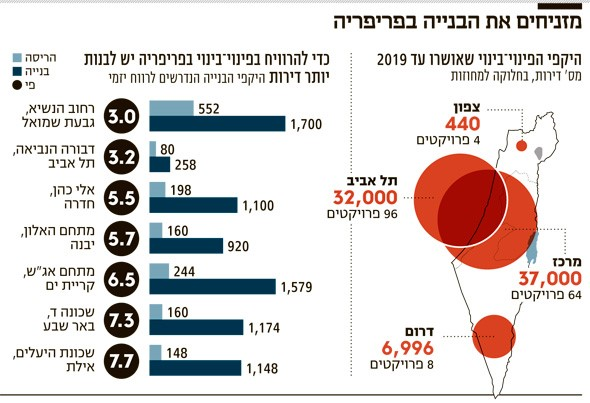Calcalist, Dotan Levy and Amitai Gazit , 13.08.2020
One of the main goals of the Urban Renewal Authority, which was established in 2016, was to establish a fund to be budgeted by the state and to encourage projects in places where land values are low, especially in the periphery. But the authority did not really devote resources to supporting this goal, and the fund never started operating. A review of the Urban Renewal Law, which is proposed under the Arrangements Law and is expected to come up for discussion in the coming weeks, clearly illustrates the problem: there is no funding for projects in the periphery. On the other hand, the law proposes signing framework agreements with local authorities that have detailed plans to add thousands of apartments, leaving the periphery out.
In fact, about five years after the start of the Urban Renewal Authority's activity, the number of projects in the periphery is still remarkably low. According to a report released by the Authority last year, 96 and 64 projects were approved in the Tel Aviv and Central Districts, including 32,000 and 37,000 apartments, respectively. In the Southern and Northern Districts, 8 and 4 plans were approved, including 6,996 and 440 apartments, respectively.

Also, similar to projects in the center of the country, also in peripheral areas the profit line for the entrepreneur is what determines whether the project will be implemented. Standard 21 requires the developer to present a profit of about 25% -30% in evacuation-construction projects, and therefore huge multipliers are needed to allow the project in the periphery to get underway. Multiplier is the ratio between the number of apartments that are demolished and those that are built. Examples of this can be seen in projects that are already planned in areas that are not even considered peripheral, ie are within the boundaries of Gedera-Hadera. For example, in a project on Eli Cohen Street in Hadera, 198 old apartments are planned to be demolished and 1,100 new apartments built (multiplier 5.5). In Ramat Yadin in Netanya, 262 apartments are planned to be demolished and 1,362 new apartments are built (multiplier 5.2), in another plan on HaGdud HaIvri Street in Hadera, 36 apartments are planned to be demolished and 274 apartments are to be built (multiplier of 7.6). To illustrate, in powerful cities in the center of the country the average multiplier is 3 (3 new apartments for every apartment destroyed).
According to Yael Dori, head of planning and transportation at Adam, Teva VeDin, "Everything is still run economically and less socially, the authority is still running like the committees that discuss these plans. Being a fund does not mean that they will fund the right plans. "And they do not continue to operate in an economic examination of the entrepreneurial profit. To this day, the authority has financed planning procedures, but not the construction itself."
 Chairman of the Government Authority for Urban Renewal, Haim Avitan Photo: Shlomi Amsalem
Chairman of the Government Authority for Urban Renewal, Haim Avitan Photo: Shlomi Amsalem
Net economic consideration"
Allegedly the supplementary lands (lands that the state allocates to an entrepreneur elsewhere in the city so that he can build on them and make all his activities in the city profitable) were supposed to help in addition to direct support for projects, but even that has difficulties. "In new programs when they say there is an allocation for supplementary land we asked that the land be annexed to the plans and they did not agree. The state continues to act like an entrepreneur. They talk about setting up the fund and removing barriers, but to make it social in the spirit of the time we are in.
Namir Caesar, the city planner of Adam, Teva and Din, adds about the multipliers: "You can see that they still continue to promote plans at multipliers of 10-8, and the consideration of how many apartments will be in each complex is net economic. I promoted projects in front of them, "There is no social aspect to working with them. The result is complexes in the heart of cities in the periphery that are detached, without sufficient allocation of public areas."
The bill also proposes to change the budgetary mechanism so that instead of the money being transferred to the fund it will be transferred to the authority, and it is estimated that it will hurt the fund. The Hagar Center for Social Housing Research and Development at the Faculty of Law at Tel Aviv University has drafted a position paper, according to which merging the fund's budget with the PA's budget will greatly limit the promotion of projects that are not economically viable; Assistance in financing the long-term maintenance of the common property; And the inclusion of affordable housing in urban renewal. Uri Ettinger, director of policy promotion at the center: "The fund was supposed to break the equality when it comes to promoting projects in the periphery and allow the goals set by the state to be realized. .
Another clause criticized by the Hagar Center is an exemption from praise tax for owners of two apartments in an urban renewal venture:
The law also proposes to set criteria for assisting authorities that have detailed plans for at least 1,000 dwellings in urban renewal, and are willing to sign a framework agreement requiring them to issue building permits for at least 4,000 dwellings in urban renewal. In return, the authority will receive a subsidy intended for supporting infrastructure for the project in the amount of NIS 30,000-20,000 per apartment. This criterion leaves out most of the local authorities in the periphery, so the Hagar Center says that framework agreements can be promoted but at the same time an additional and separate mechanism must be established that ensures budgeting of projects in the periphery without a framework agreement.
In Hagar and Adam, Teva and Din also criticize the planning aspect. According to them, the projects promoted in urban renewal produce complexes detached from the environment, without public transportation and without sufficient public spaces. Also the high multipliers produce high construction that increases the maintenance costs for the tenants. "In many of the projects it can be seen that in practice the original population cannot stay in the new neighborhoods due to the high costs of maintaining and managing the new apartments due to the construction of large apartments only and the lack of commercial and employment space and accessible public transportation," says Dori.
 Yael Dori, Head of Planning at ATD Photo: PR
Yael Dori, Head of Planning at ATD Photo: PR
One of the most prominent proposals in the law is to reduce the rate of consent required to promote evacuation-construction projects from the current 80% to only 67%. Such a move is intended to neutralize tenants who are serial opponents and blackmailers, but may at the same time increase the pressure on senior citizens. This move was also opposed by Merav Cohen, the Minister of Social Equality, who believes that the consent rate should be reduced in moderation and a mechanism should be created that will take care of the elderly. In its recommendations for the discussion of the law, Cohen proposes establishing a team of representatives from the Urban Renewal Authority, the Ministry of Justice, the Budget Division, local authorities and the Ministry of Social Equality, which will formulate a plan to address senior citizens, including legislative amendments. She also writes that "adverse effects in the conduct of apartment owners" must be prevented, including stipulation in the NPA 38 conditions with respect to the elderly similar to those set forth in the eviction-construction arrangement, the creation of cause of action and strong ties in connection
With "offensive stamping" and more.
"NIS 25,000 per apartment"
In an interview with Calcalist, Haim Avitan, chairman of the Urban Renewal Authority, said: "We intend that over the years the money will also be directed to the periphery, where there is no economic viability. We intend to go for projects with a smaller number of units. We will discuss each project on the merits of a project according to progress and demand. We will not just take a city that is not in demand. We will do it in a more moderate way according to demand. There are projects that we started planning in Kiryat Shmona, Tiberias, Safed, Beit She'an and Eilat. "
Avitan also referred to the framework agreements: "The plan is to use the funds of the Urban Renewal Fund, mainly for roof agreements for urban renewal. We will pay about NIS 25,000 per apartment, provided that the local authority has plans for 4,000 apartments in five years." NIS 200 million, and the issue is still in dispute between the Ministry of Finance and the Ministry of Construction.As for the periphery, he says that the plan is to use some of the fund's money also to subsidize non-economic projects in peripheral cities.



